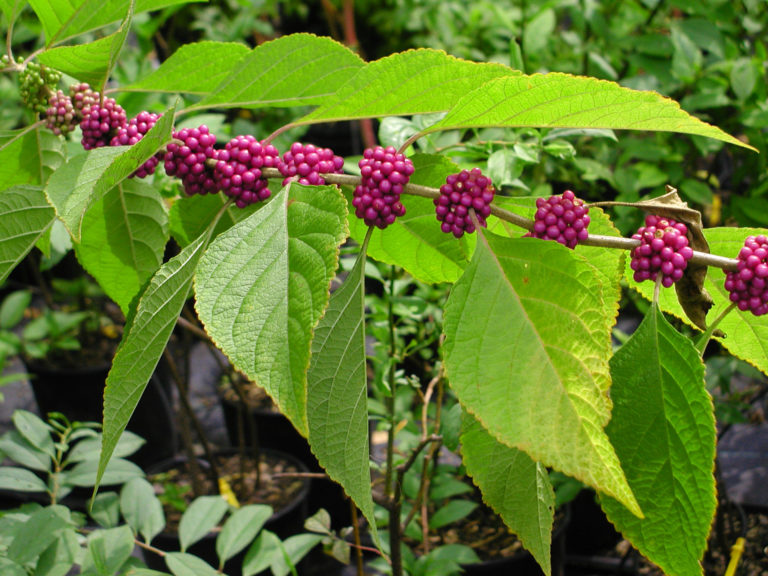If you think the outrageous color of Beautyberries is as much fun as we do, do not hesitate to grow this loosely open shrub on your property. It is robust and trouble-free, spectacular to look at, and attracts all manner of butterflies and birds. At the same time, it is highly recommended as a tick repellent! How desirable can one plant get? Some folks let it go completely, especially in a partial shade location, and it can become quite a presence (six feet x six feet), but most prune it back when the birds have had their feast of berries, to control its top growth. Some even cut it to 12-18 inches from the ground each season, with no negative consequences as its tiny pink blossoms emerge on the new growth. It thrives in full sun, and flowering and fruiting are best in high light. This plant is a gift to the beginner as well as to the experienced gardener. It occurs in woods, swamps and stream banks of the Southeastern U.S. from Virginia to Florida, West to Texas.
NURSERY HOURS
Wednesday: 10-4 Thursday: 10-6 Friday-Saturday: 10-4 Sunday: 12-4
Callicarpa americana

Key Info
Scientific Name: Callicarpa americana L.
Common Names: American Beautyberry, Spanish Mulberry, French Mulberry, Bermuda Mulberry, Sourberry, Sowberry
Family Names: Verbenaceae (Verbena or Vervain Family)
Plant Type: Tree / Shrub
Leaf Retention: Deciduous
Flower Color: Pink
Special Characteristics: Good for flower arrangements, Attracts bees, Attracts butterflies, Candidate for fire management, Attracts birds, Good wildlife cover
Additional Info
Habit: Open shrub with spreading, arching branches
Height: 3'-6'
Spread: 3'-6'
Soil Conditions: adapted to a wide pH range, as well as a range of texures (sandy, loamy, clay)
Leaves: Leaves are opposite, light green, oval with toothed margins; leaves turn chartreuse late in the season, contrasting with purple berries.
Flowers (or reproductive structures: In late spring, small, pastel pink flowers cluster between the nodes.
Fruit: Clusters of bright purple berries surround the stems at nodes in fall. Each berry contains 2-4 seeds.
Natural Distribution: Woods, thickets, swamps, stream banks
USDA Hardiness Zone: 7 to 11
USDA Wetland Indicator Status in NC: FACU
Pollination: Bees, butterflies, other insects
Wildlife Connections: The seeds of American Beautyberry are an important food source for birds and small mammals. At least 10 species of birds feed on the fruit, especially northern bobwhite. The fruit is also eaten by raccoon, opossum, and gray fox. American Beautyberry is considered one of the most desirable spring and summer browse of white-tailed deer. Cattle occasionally browse on the leaves (Forest Service: fs.fed.us/database).
Propagation: Seeds, root cuttings, soft wood tip cuttings.
